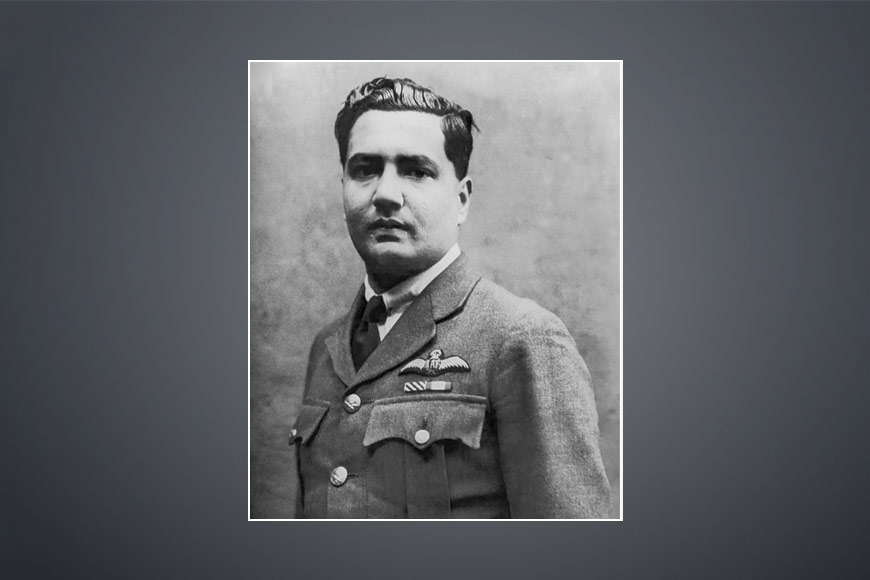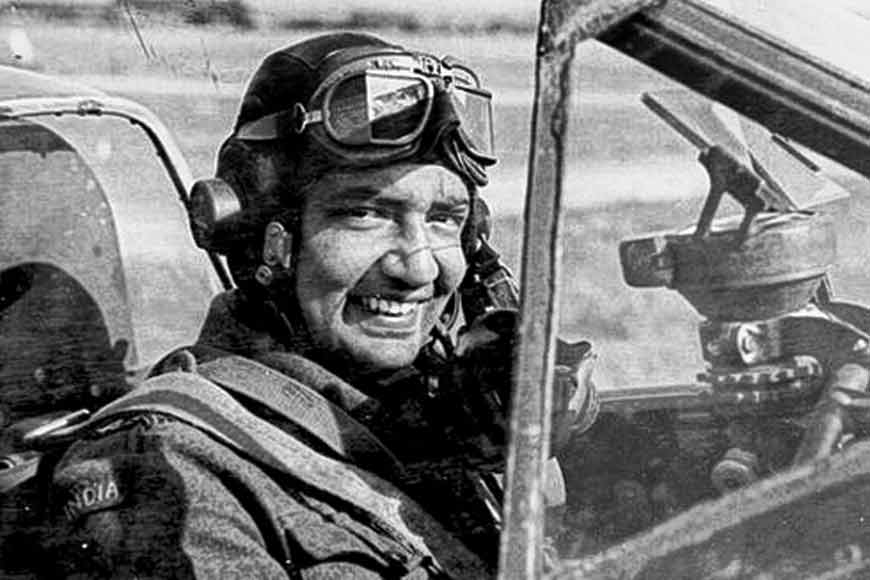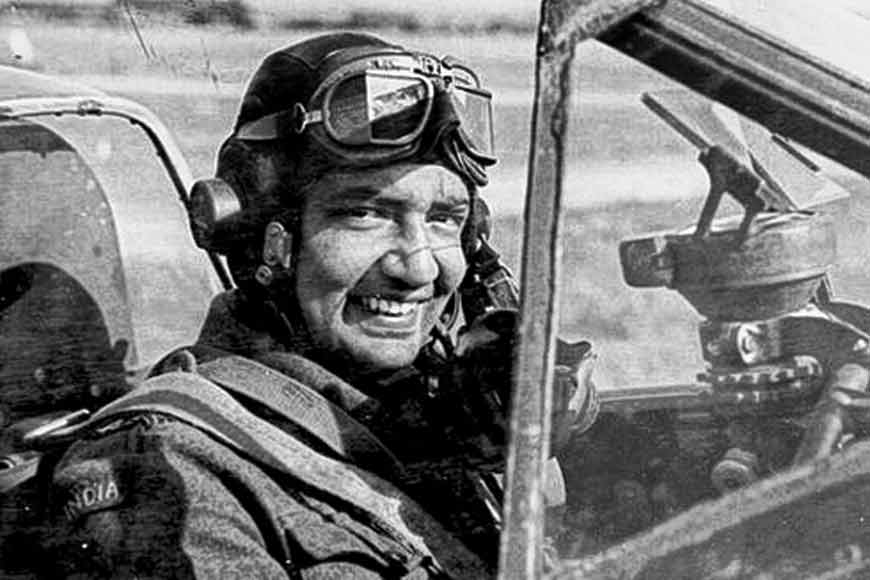The first Indian Air Force pilot to get a Distinguished Flying Cross was a Bengali! - GetBengal story

Wing Commander Karun Krishna Majumdar
During the Second World War (1939–1945), India was a part of the British Empire. Being an integral part of the Allied Nations, large troops of Indian soldiers were deployed to fight against the Axis powers in different parts of the world. Meanwhile, the freedom movement was gaining momentum within the country. The National Congress did not support the British war efforts and demanded independence before it would help Britain. The year was 1941 when the British government decided to mobilize the Indian Air Force (IAF) to fight the Japanese in Burma. The Warrant officer of IAF, Harjinder Singh was not convinced that Indians should fight for the British and he even raised the question in private. At this point, his Indian commanding officer, Squadron Leader Karun Krishna ‘Jumbo’ Majumdar, reasoned with him: “Harjinder, if we do not fight in this war for the damned British, we shall be nothing better than a flying club when the war ends. We must fight, and we must aim to expand the IAF while the going is good. After the war is won, India will be a Dominion, and we shall have to run our own Air Force.” (Extract from former RAF officer and British Airways pilot Mike Edwards’ memoirs).
The Royal Indian Air Force carried out its first assault mission against Japanese troops stationed in Burma. The IAF was also key to breaking the siege of Imphal when the westward advance of Imperial Japan came to a halt. Karun Krishna Jumbo’s prediction turned out to be prophetic and India did become a Dominion in 1947 though he did not survive to see it himself.
Wing Commander Karun Krishna Majumdar was an exceptional man. He was the first Indian Air Force pilot to be honoured with the Distinguished Flying Cross (DFC) by the Royal Air Force not once, but twice for his daring leadership during World War II. In 1945, when Majumdar was awarded a second Bar to his DFC, The London Gazette praised him for his operational skills and LIFE magazine listed him as one of the 12 best pilots in the allied air forces for his work in Burma and Europe.

Born on September 6, 1913, in an aristocratic family in Calcutta, Majumdar was the grandson of Womesh Chunder (WC) Bonnerjee, co-founder and first president of the Indian National Congress from his maternal side. He was educated at St. Paul’s School, Darjeeling. By the time he was in his teens, he was already over six feet tall, and of strong build and was nicknamed ‘Jumbo’ – one that stuck with him till his last day. The flying bug bit both Jumbo and his elder brother, Jai Krishna who took the Air Force entrance examination in 1932 and passed with flying colours. They sailed aboard where Jai Krishna joined Sandhurst and Jumbo took admission in Royal Air Force (RAF) College, Cranwell. Jumbo passed out in December 1933, sixth out of the list of 30, was gazetted as a Pilot Officer and posted to Old Sarum. After finishing his course there, he was posted briefly to No. 2 Squadron R.A.F. before returning to India to join the recently formed No. 1 Squadron, Indian Air Force, in November 1934.
In May 1935, Majumdar was in Quetta when the earthquake struck and with other members of the Squadron, he took part in the rescue work. On July 9, 1935, he received his commission as Flying Officer, subsequently becoming Flight Commander “C” Flight, No.1 Squadron, which moved to Fort Miransah, Waziristan. Promoted to Squadron Leader, Majumdar took command of No.1 Squadron in June 1941. In the following January, equipped with Lysanders, the Squadron arrived in Burma and was based at Tuogoo Airfield from February 1, 1942. This was going to be an eventful month. The next day, the Japanese attacked the airfield, destroying most of the existing Allied installations and aircraft, except the I.A.F.’s Lysanders, which stood at the base unscathed.
Majumdar seethed with anger and planned a retaliatory raid and on the following day, he settled himself into a Lysander armed with two 250 lb. bombs attached to improvised racks. When one of his juniors asked: “Where are you going?” he replied: “Just for a little outing—I’ll be back soon!”

The use of Lysanders in offensive bombing missions had previously been unheard of, but Majumdar flew at treetop level in the direction of the Japanese base at Mae-Huangsu. He dropped his bombs on an aircraft hangar, destroying both it and the aircraft it contained. This surprise assault left the enemies dumbfounded. However, this was just the onset of Majumdar’s strategy. On the following day, he led the entire squadron on a further bombing mission when they succeeded in destroying several buildings, wireless installations and ground aircraft. On the next day No.1 Squadron was called to Mingaladon, just outside Rangoon, and joining with 28 Squadron, they carried out a raid on Moulmein Dockyards under Majumdar’s leadership. Direct hits were scored on the railway station and various dockyard buildings.
By the end of the month, the situation in Burma had deteriorated to the extent that the R.A.F. and No.1 Squadron were ordered back to India, with the exception of a few I.A.F. pilots, including Majumdar who quickly became accustomed to frequent solo reconnaissance flights over Thailand. During one such foray, he spotted a new Japanese airstrip. He reported it to the Intelligence Officer who refused to believe him, so he invited the I.O. to take a ride in his Lysander. On pointing out the feature, the I.O. still refused to believe Majumdar, claiming the strip was not straight enough to land on. Immediately Majumdar pulled his aircraft over and performed a touch-and-go landing, thus finally convincing the I.O. Majumdar’s seeming disregard for his own safety on solo bombing raids and leading others against what appeared to be insurmountable odds made him a legendary figure both in the Royal Air Force and among his own countrymen.
Also read : Decorated war hero of the Indo-China War 1962
In September 1941, when No. 1 IAF Squadron and No 28 RAF Squadron were grounded on account of a technical snag, Majumdar dared to go for a test flight with a modification of wooden tail wheels, as suggested by a colleague, despite being aware of the risks involved. Courage was one of the qualities that he valued most in life, and truthfulness. In his diary, he made an entry that said, “Courage pays greater dividends than timidity”.
On another occasion, Majumdar had to make a forced landing in the Shan jungle, and after spending four days alone in the wilderness, a group of Shan tribesmen rescued him. Finally, at the beginning of April, he was among the last Allied pilots to leave Burma when he managed to get out of Rangoon aboard a Flying Fortress on March 11. For his leadership of the Squadron during the Burma Campaign, Majumdar was awarded the Distinguished Flying Cross (DFC) — the first Indian Officer to be so decorated.
For the next two years, Majumdar remained in India, employed in various staff and flying assignments. By then, he was Wing Commander of IAF and played a crucial role in building the IAF, establishing several training centres across India and increasing the number of squadrons from one to nine by 1944. He was keen to participate in the European war, especially the anticipated operation that would become known as D-Day and sought clearance from his superiors to do so.
He arrived in England in mid-March 1944 and took up active flying duties at the beginning of June when he was attached to 268 Squadron in a reconnaissance role. By the end of his operational tour on September 20, he had flown 65 operational sorties in 100 days. Of particular significance were Majumdar’s reconnaissance of the heavily fortified Falaise Gap, photographs which were vital for the progress of the Allies. For his work in North-Western Europe, he was awarded a bar to his D.F.C., thus becoming the only Indian Officer to receive a second award.
Majumdar returned to India late in 1944. Early in the New Year, he was asked to be part of a public awareness programme and help boost the I.A.F.’s recruitment drive. He was killed on February 17, 1945 at Walton Airbase, Lahore while participating in an air display. He had resolved to perform an aeronautical display in a Hurricane, even though he knew the particular aircraft he was using had a history of mechanical problems. Roaring into the air before a large audience, he executed some high-level turns and then produced a maneuver involving a dive, during which one of the undercarriage legs became unlocked from the wheel well and deployed down. The Hurricane’s stability was upset and it stalled and crashed, killing Majumdar instantly. He was just 31 years old at the time of his death. The Indian Air Force bought Majumdar’s Distinguished Flying Cross (DFC) medal and bar from a Britain-based auction house in 2015 and they are currently on display at the IAF museum.











